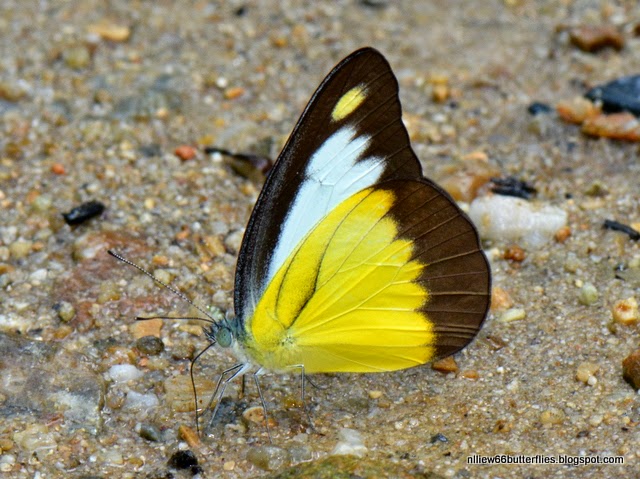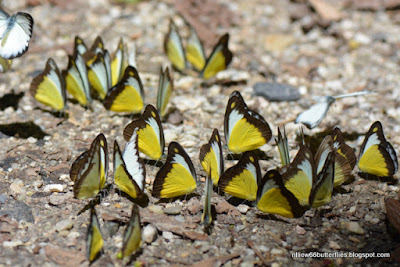Probably the commonest pierid that inhabits the forested path, it is found throughout the year but most abundant from March to July. It is an unmistakable butterfly, its white uppersides contrasting with its chocolate bordered undersides and the lemon yellow hindwings against its white forewings on the undersides (pix below). Sometimes, they can be seen congregating in large numbers with Graphiums and other pierids on a sunny day on a moist spot.
Habitat indicator
RSP
|
WV
|
PG
|
VF
|
FTR
|
SC
|
LWDF
|
LWPF
|
LMEF
|
UMN
|
MN
|
x
|
x
|
x
|
x
|
Frequency observation chart: (S marks the usual occurences, H marks an unusually high occurence, F for first record)
2013
| |||||||
Mac
|
Apr
|
May
|
Jun
|
Jul
|
Aug
|
Sep
|
Oct
|
S1-3
|
S1H
|
S1H
|
S1-3
|
S1-3
|
S1-3
|
S1-3
|
S1-3
|
2013
|
2014
| ||||||||||
Nov
|
Dec
|
Jan
|
Feb
|
Mac
|
Apr
|
May
|
Jun
|
Jul
|
Aug
|
Sep
|
Oct
|
S1-3
| S1-3 | S1-3 | S1-3 | S1-3 | S1-3 | S1-3H | S1-3 | S1-3 | S1-3 | S1-3 | S1-3 |
2014
|
2015
| ||||||||||||
Nov
|
Dec
|
Jan
|
Feb
|
Mac
|
Apr
|
May
|
June
|
Jul
|
Aug
|
Sep
|
Oct
|
Nov
|
Dec
|
S1
|
S1-3
|
S1-3
|
S1-3
|
S1S2
|
S1S2S3
|
S1
|
S1
|
S3
| |||||
2016
|
|||||||||||
Jan
|
Feb
|
Mac
|
Apr
|
May
|
Jun
|
Jul
|
Aug
|
Sep
|
Oct
|
Nov
|
Dec
|
S1S3
|
S1S3
|
S1
|
S1S3
|
S1S3(H)
|
|||||||
2017
|
|||||||||||
Jan
|
Feb
|
Mac
|
Apr
|
May
|
Jun
|
Jul
|
Aug
|
Sep
|
Oct
|
Nov
|
Dec
|
S1S3
|
S1(H)S3
|
S1(H)
|
|||||||||
2018
|
|||||||||||
Jan
|
Feb
|
Mac
|
Apr
|
May
|
Jun
|
Jul
|
Aug
|
Sep
|
Oct
|
Nov
|
Dec
|
S
|
S
|
S
|
S
|
S
|
S
|
S
|
S
|
S
|
S
|
||
2019
|
|||||||||||
Jan
|
Feb
|
Mac
|
Apr
|
May
|
Jun
|
Jul
|
Aug
|
Sep
|
Oct
|
Nov
|
Dec
|
S
|
S
|
||||||||||
2020
|
|||||||||||
Jan
|
Feb
|
Mac
|
Apr
|
May
|
Jun
|
Jul
|
Aug
|
Sep
|
Oct
|
Nov
|
Dec
|
06 August 2013 @ 12:17
24 August 2013 @ 11:53
Above two photos of its uppersides (male): 12 May 2013 @ 11:57
Above 2 photos of a female visiting flowers: 30 March 2013 @ 12:06
14 December 2013 @ 13:53
17 December 2013 @ 11:47
09 March 2014 @ 13:05
* * * * *
01 May 2014 @ 11:03
17 December 2013 @ 11:47
09 March 2014 @ 13:05
* * * * *
01 May 2014 @ 11:03
Above 2 photos of a form (or variant?) as they have decidedly dark dusted veins on the undersides of the HW.
Notice the two vars. in this photo from 14 April 2014
14 Mac 2015 @ 11:42
This one has a much darker dusting: 12 Apr 2015 @ 11:28
15 April 2017 @ 12:22
* * * * *
22 May 2016 @ 12:24
* * * * *
Crateva religiosa, among many plants used as a host plant.



















No comments:
Post a Comment